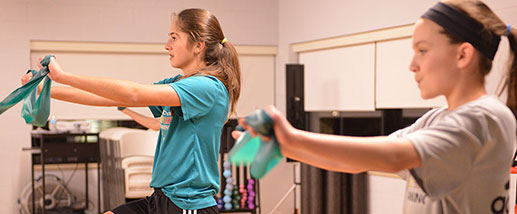Greenville Resident Carol Roy Survives Two Thoracic Aortic Aneurysms
 Carol Roy knew she had a thoracic aortic aneurysm that John Morris, DO, with Mercy Health Vascular Surgery was monitoring.
Carol Roy knew she had a thoracic aortic aneurysm that John Morris, DO, with Mercy Health Vascular Surgery was monitoring.
So in 2014, when the aneurysm became larger, she was not surprised that Morris referred her to the Director of Endovascular Services at Mercy Health Saint Mary’s, Joshua I. Greenberg MD, RPVI, for further care.
An aneurysm is a ballooning of a blood vessel and, in Roy’s case, it was an aneurysm of the aorta — the body’s largest blood vessel that travels from the heart to other vessels through which it delivers oxygenated blood to the entire body.
With the worsening of her condition, Roy and her daughter, Karen Bull, were thrilled to consult the first provider at Mercy Health in Grand Rapids to surgically repair a thoracic aortic aneurysm with a stent-graft. In fact, during his career, Greenberg has completed more than 100 such procedures.
“He listened to me and showed me with pictures what was happening in my body,” said Roy. “He explained everything.”
Described by the mother and daughter as “compassionate, humble and outstanding,” Greenberg took the time to discuss all of the options for and aspects of Roy’s care.

Bull is the “designated daughter” who attends most medical appointments with her mom and keeps track of Roy’s medical history.
“Dr. Greenberg gave us the risks and benefits — including the risk of paralysis — but we knew that the aneurysm was getting larger, so we needed to do something. A rupture would mean disaster,” said Bull. “We felt confident about Dr. Greenberg’s skills.”
As a lifelong Catholic, Roy was pleased that during her hospital stays, “chaplains prayed for me and even gave me a prayer blanket.” During her procedures, Roy’s faith was unwavering in both God and Greenberg that she would have positive results.
“Because her vessels were small, we created a bypass to deliver the stent into her aorta,” said Greenberg about the successful procedure for her first aneurysm.
Following her surgery, Roy had to lie flat to avoid post-surgical complications. “We love the nurses at Mercy Health. They are very caring, and I had great care. The nurses checked me constantly. You couldn’t ask for nicer people,” said Roy.
After a week, Roy returned home and received follow-up home care. Greenberg urged Bull to watch her mother for signs, such as, “If she gets any back pain or shortness of breath, take her to the Emergency Department.” Greenberg had identified a second aneurysm that his team would monitor over time for changes. First Roy needed to heal from surgery; they would treat the second aneurysm in the future.
A few months later, when Roy began to suffer from back pain, Bull took her mother to the local ED, and from there, Roy was transferred to another health care system in Grand Rapids. Providers in that hospital noticed that her second aneurysm was beginning to affect Roy’s health.
“The other doctors offered to provide care for my mother’s aneurysm, but my mom wanted to stay with Dr. Greenberg for her follow-up care after her first aneurysm and to repair her second aneurysm,” said Bull.
In 2015, between her surgical treatment with Greenberg for each aneurysm, Roy had a CT scan done at another health care system for another condition and had a reaction to the contrast dye during the scan. However, no one informed the providers at Mercy Health about the reaction.
So when Roy underwent a contrast CT scan at Mercy Health as a follow-up after her first aneurysm, she went into complete cardiac arrest. Bull was out of town at the time, so the vital information about Roy’s previous adverse reaction was not relayed to providers at Mercy Health.
With clear recollection of that day, Greenberg shared, “Staff at Mercy Health Saint Mary’s performed CPR and revived Carol. Her recovery was not only miraculous, but in 2016, we were later able to address her second aneurysm.”
Roy’s second aneurysm was located near the aortic arch, where branches of the aorta go to the brain. “We needed to reroute the blood flow to the branches through multiple bypasses before we placed a stent to address her aneurysm,” said Greenberg.
This second procedure was far more complex than the first one, but it was also successful.
Now at age 76, this mother, grandmother and great-grandmother volunteers locally at a charity. She credits Greenberg’s skill and Mercy Health with her ability to have an active lifestyle. “I still drive, run errands and like to be doing things.”
Confident that Roy will have normal life expectancy, Greenberg explained that stents require long-term surveillance; some patients will need a secondary procedure.
“We’ll provide follow-up care for Carol as we do for all our patients with aneurysms, whether they are routine or complex. We’re happy to be available 24/7.”




